KPC-350BH (PC164C) Low Light CCTV Camera
© Brooke Clarke 2007
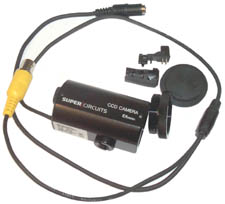
Camera, C/CS adapter ring, rubber dust cover, auto iris plug & shell.
Models - Table
DC Power
Lens Options
Auto Iris Note
Controls
Inside
Problems
Related
Links
Background
There is a
KPC-xxx family of
security CCTV cameras all packaged in a common housing that's offered
with many options. They all use a 1/3" imaging chip. Super
Circuits sells it as their P164C and most other vendors sell it as the
KPC-350BH. Links in the table below.
The options are:
- Black & White or Color
- U.S. or European Specification
- High Resolution or standard
- Extra light sensitivity or standard
Models
Packages
Tube w/o Lens
This is the P164C or KPC-350BH.
The big advantage is the flexibility you get with the C/CS lens
mount. A Cine lens, or with an adapter a 35 mm camera lens can be
used. Or with a different adapter it will plug into a telescope
eyepiece.
The round printed circuit boards in this camera are 0.95" diameter.
There is a screw in ¼-20 tripod socket that can be installed
either on the bottom or the top of the housing. A 25¢ coin
is the ideal tool for making the change.
Raw Board
The raw PCB comes in a number of
versions, one uses the standard (12 mm ?) board lens and the others
have a fixed lens. The smallest volume option. Exposed if
used raw so needs protection. Good for integration into a covert
camera, like a clock, book, etc. There are long skinny PCBs that
can be integrated into a fat pen.
Cube
The raw board in a box that's just a
little larger than the board. Has a "U" bracket to mount the
box. The boards are different sizes from about 1.5" square down
to about 3/4" square. depending on the chip set. I think for this
series they are very near 1" square. The Cubes use the same (12
mm?) lens as the raw boards. The cube can be mounted inside a 1
¼" tube that will fit most amateur telescopes.
Lipstick
This is a tube with lens installed all in a weatherproof housing that has a ¼-20
threaded hole on the back that can be used with a bracket to mount on a
wall. The advantage is the weatherproof small package at a cost
much lower than putting another camera in a weatherproof housing.
I'm not sure how you focus or adjust the lens.
All using similar Sony chip sets as the PC164C. The model number contains B for B&W or C for Color.
EX in the KT&C model number means lower Lux. 650 means hi res and 350 is standard res.
All the model numbers have an "H", maybe related to the generation or chip set.
If you have information on other brands or models that are Sony chip set cameras for this table
let me know.
B&W is a misnomer, the camera is not Black or White, but really monochrome.
Tube
w/o Lens
|
B&W
350BH
|
B&W
350BHEX
KPC-350BH
PC164C
|
B&W
650BH
|
B&W
650BHEX
PC164-EX3
KPC650BHEX7
|
B&W
PC164EX-SLL4
|
B&W
PC164CEX-26 |
Color
350CH
|
Color
350CHEX
|
Color
650CH
|
Color
650CHEX
PC165C
|
Board
|
|
PC402XS
3.7 mm
|
|
|
|
?
|
|
|
|
|
Cube
|
|
PC180XS
3.6 mm
|
|
|
|
?
|
|
|
|
PC182XS
3.6 mm
|
Lipstick
|
|
|
|
PC88WR
3.6 mm
|
|
?
|
PC156WR
3.6 mm
|
PC75WR
na mm
PC85WR
na mm
|
PC802WR
4 - 9 mm Zm
|
PC88WR
3.6 mm
|
Spec
|
EIA
note 1
|
EIA
note 1
|
EIA
note 1
|
EIA
note 1
|
EIA
note 1
|
EIA
note 1 |
NTSC
Note 2
|
NTSC
note 2
|
NTSC
note 2
|
NTSC
note 2
|
Res
|
420
|
420 |
600
|
600 |
600
|
600
|
380 |
380 |
480 |
480 |
Lux
|
0.02
|
0.00035
|
0.02 |
0.000355 |
0.000255 |
0.0001
|
0.5
|
0.05
|
0.5 |
0.05 |
# Pixel
|
537 x 505
|
510 x 492 |
768 x 494
|
768 x 494 |
768 x 494 |
508 (V) X 811 (H) |
510 x 492
|
510 x 492 |
768 x 494
|
768 x 494 |
CCD
|
|
ICX254AL
|
|
ICX258AL
|
ICX258AL
|
?
|
|
|
|
|
Output
|
|
CXA1310AQ
|
|
|
|
?
|
|
|
|
|
Timing
|
|
CXD2463R
|
|
|
|
?
|
|
|
|
|
Note 1 CCIR version also availale
Note 2 PAL version also available
Note 3 Misnamed: -EX should have been -HR
Note 4 Dec 2007 rumored to be announced 1Q2008
Note 5 the Lux values have been slightly modified from the spec sheet
numbers to indicate relative sensitivity between these three cameras
Note 6 This camera was introduced Jan 2008.
Note 7 Adirondack Video Astronomy carries the KPC650BHEX.
DC Power
The camera is specified to run from 12
VDC @ 160 ma. Part of that current may be an allowance for 50 ma
to dirve an auto iris lens?
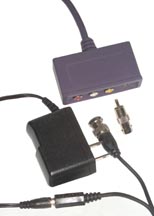
The violet box is the input to my computer. Only the yellow composite video input is used with the PC164C camera.
The 100' Cable from Super Circuits ( ) is a Siamese where one
side is the video coax with BNC-m connectors on both ends and the other
side is the DC feed with 2.1x5.5 mm plug and the other end with 2.1x5.5
mm jack. Since most video inputs are an RCA jack you need a BNC-f
to RCA-m adapter like the Radio Shack 278-250.
The wall-wart power supply is one of the skinny switching mode types
rated for 12 volts @ 500 ma. Much lighter and smaller than the
old type linear power supplies. It has the 2.1x5.5 mm plug like
is used to power many items.
In addition to the BNCf - RCAm adapter it's also handy to have a
BNCm-BNCm adapter to replace the 100' cable. I.e. by using the
two adapters you can convert the camera's BNCf to an RCAm which is
needed for most composite video inputs.
Lens Options
C/CS Mount Lens
6 - 60 mm Varifical Lens Settings
If you look into the objective end of the lens with the lens removed
from the camera and with a light background and work the controls you
can see that the maximum amount of light goes through when it's set for
Far, Open, Telephoto or Wide angle does not make any difference.
Note the very front of the lens is fixedly attached to the mounting
thread end and the three adjustment rings between are all free to
rotate. The center Open/Close iris control can close completely,
so no light goes through the lens. At first this is what I
thought was happening, but now realize the camera itself is
intermittent.
The settings seem "touchy" especially the focus. A tiny bit of movement and it's out of focus.
I have the camera on the Arri tripod which is near my computer monitor
with the lens pointing out the front door at trees that are at least
100 feet away.
Sometimes when switching from DC to Video there's a change in image
brightness. This does not make sense because there's nothing
connected to the auto iris socket. Switching from ALC to B/S
should and does make a difference.
It's very hard to setup this lens in the daytime. The iris needs
to be right on the edge of being closed. Maybe there's another lens
that's less hassle to use? Ans. With a camera that's very
sensitive a normal lens needs to be stopped way down and the iris
adjustability between say f/64 and iris closed is non existant.
What's needed is an auto iris lens of the new type that has a much
wider f# range like F/1.4 to f/360. For more see the
P-38 web page or the
Sky-Weather-Astronomy web cam info pages.
Nikon to C Mount Adapter
Since I have some Nikon 35mm camera
lenses I've ordered an adapter so they can be used on the PC164C
camera. It turned out not to be a Nikon adapter, but a similar bayonet
type.
1 1/4" to C Mount Adapter
This adapter fits into the eyepiece
holder for most amateur telescopes. A have a few scopes that
could be used this way. If no additional optics are used the
scope objective focuses directly on the CCD chip in the camerea, called
prime focus mode.
Auto Iris Note
With a camera, like this one, that's extreamly light sensitive has a
normal manual lens installed there's way too much light geting to the
sensor in daylight for the camera to work properly. Even a first
generation auto iris lens (f/32 +/-) lets way too much light into the
camera. The second generation auto iris type that can stop down to
(F/360 +/-) will allow the camera to be used in the daytime.
Controls
DC-VID
There are two types of auto iris C or CS mount lens. In one type
a video signal is fed to the lens and these typically have one or two
of pots on the lens to set the levels. The other type is fed a DC
control voltage generated by the camera and has no pots. So you
set the DC-VID switch to match the type of auto iris lens. If
you're not using an auto iris lens the switch position should not
matter. But there may be an effect when the switch is in
the video position and you don't have a 75 Ohm load on the video wire
in the auto iris socket, so using the DC position when not using an
auto iris lens may be a good choice.
E/S - ALC
E/S is an exposure control method that uses an
Electronic Shutter speed (like the shutter speed on a film camera) and
Automatic
Level
Control
uses the gain of a video amplifier. This camera in stock form
does not have any manual control of the video amp gain (there are web
pages that have a modification to add manual gain control).
If the auto iris lens is using a video input then you can not use ALC
since that would make the video level always the same and so would not
provide the lens with the signal it needs. That's why you must
select Electronic Shutter when using a video auto iris lens.
The
Super Circuits PC38 camera has a user
option to choose either shutter priority or gain priority but this
camera does not. I haven't figured out which it uses. The
most dynamic range would come from using the E/S setting so that after
the lens stopped down on a bright day then the shutter speed could
further reduce the exposure. The other way would be for the
shutter speed to be at the fastest setting with the lens wide
open. This provides short exposures good for moving images.
As it gets darker the shutter speed will slow down and finally get to
1/30 second per frame (1/60 second per field), i.e. the E/S is no
longer doing anything and all the time possible is used for light
gathering. As it gets more dark the lens opens up to it's widest,
maybe f/1.2 or thereabouts. Now the only thing that can be done
to see more is increase the gain. So if you're working with
daytime images the E/S setting is of help and if working with dark
night time scenes the ALC setting is more help.
In either switch setting the camera is going to try and get an exposure
that's about the same as a Kodak standard gray test card. This
will be close to the correct exposure for normal scenes. For
astronomical use this may be about correct for imaging the moon or a
planet that's filling most of the field of view. But if the image
is mostly of black night sky with some stars the camera setting will be
too high, i.e. the background will be the target gray, not black.
DC Level
Adjusting the pot allows matching a DC auto iris lens to the
sensitivity of the camera. If you're working primarily with night
time scenes then setting the pot at night will give the best results
for those scenes but may not be optimum for bright daytime scenes and
vice versa.
If you're not using an auto iris lens the setting does not matter.
Inside
Disassembly
Remove the four Phillips screws that
are next to the CCD. The screwdriver needs to exactly match the
screw and some downward force is needed to break them loose.
Remove the two small set screws at the back. Slide the chassis
out of the case.
There are four printed circuit boards in back to front order: Back, Power, Main & CCD.
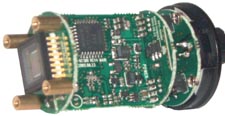
The CCD is on the left end PCB marked KPC-600BH Rev 4 CCD,
2002/8/23. The main PCB is marked KPC-600BH Rev4 Main,
2002.08.23. To the immediate right of the main board is the Power
board marked KPC-600BH, Rev4 Power, 2002.08.23. To the
right of the right board is the Back board that has the pins from
the two switches and the auto iris connector soldered to it.
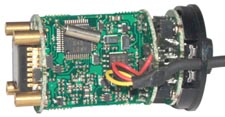 The
cable has black (gnd), yellow (video out) and red (+12 VDC in) wires
that are soldered to the right side board, not the Back board marked
KPC-600BH, Rev4 ES1 Back, 2002.08.23
The
cable has black (gnd), yellow (video out) and red (+12 VDC in) wires
that are soldered to the right side board, not the Back board marked
KPC-600BH, Rev4 ES1 Back, 2002.08.23
Although the cylindrical crystal is seen on this side, it's connected to an IC on the other side of the main board.
Problems
This camera came
packed on the bottom of a box with nice strong peanuts on top of it, not in the center of the peanuts.
I had intermittent problems and returned it for repair. It came back marked "Unable to recreate issue".
10 Sep 2007 - there's no question that the "Y" joint of the video
coax is were the problem is. When the monitor goes black (no
video) the bench power supply shows the same current as before the
problem, meaning it's a video problem not an open or short in the DC
power wiring. I've asked for a replacement "Y" cable but haven't
heard back. They replaced the whole camerea.
Related
Super Circuits P-38 (Mintron 63V5) Color Integrating Low Light CCTV Camera
Harbor Freight Color Security CCTV camera
PC33C - Super Circuits general purpose camera
Web Cam 2 - using in still image mode where
an image is grabbed at some interval and the .jpg is uploaded to the
server. Until the 4 input video card gets here only one camera at
a time can be connected to the computer. My 2-way satellite connection has nowhere enough bandwidth to support anything like live video.
7" TFT Color Monitor
Links
Korea Technology & Communications(KT&C) -
Dave Gault - Video Astronomy - First experiences with a PC164
camera
A Video Occulation Primer -
IVC200 - 4 channel capture card. uses 4 Conexant CX25878 chips
Back to Brooke's PRC68, Products for Sale, Optics, Astronomy, Star Brightness-Security CCTV, Binoculars, Stellar Time, CCD Astronomy, Home page
[an error occurred while processing this directive] created 6 Aug 2007

 The violet box is the input to my computer. Only the yellow composite video input is used with the PC164C camera.
The violet box is the input to my computer. Only the yellow composite video input is used with the PC164C camera.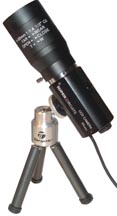
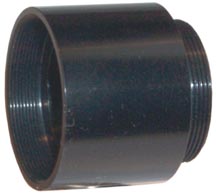

 The
cable has black (gnd), yellow (video out) and red (+12 VDC in) wires
that are soldered to the right side board, not the Back board marked
KPC-600BH, Rev4 ES1 Back, 2002.08.23
The
cable has black (gnd), yellow (video out) and red (+12 VDC in) wires
that are soldered to the right side board, not the Back board marked
KPC-600BH, Rev4 ES1 Back, 2002.08.23